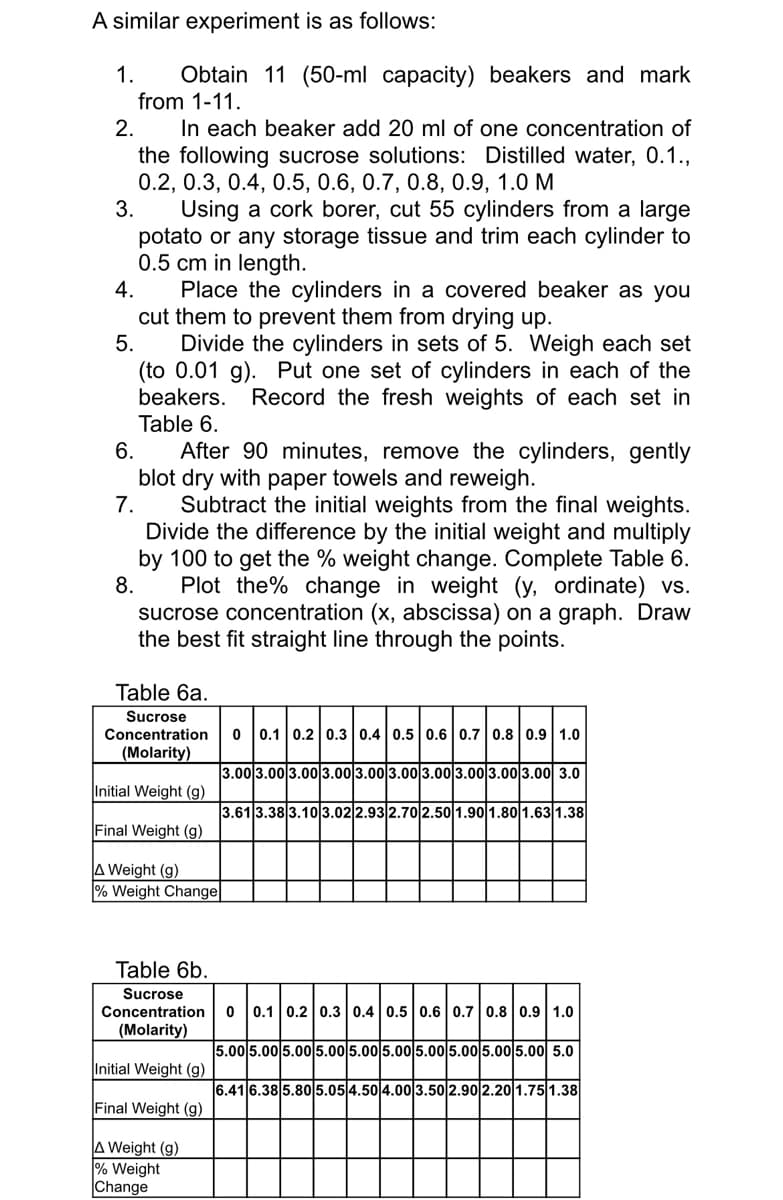Table 6b. Sucrose Concentration 0 0.1 0.20.3 0.4 0.5 0.6 0.7 0.8 0.9 1.0 (Molarity) 5.00 5.00 5.00 5.00|5.00 5.00 5.00 5.00 5.00 5.00 5.0 Initial Weight (g) |6.416.38 5.80 5.05|4.50 4.00 3.50 2.90 2.20 1.751.38 Final Weight (g) A Weight (g) % Weight Change
Table 6b. Sucrose Concentration 0 0.1 0.20.3 0.4 0.5 0.6 0.7 0.8 0.9 1.0 (Molarity) 5.00 5.00 5.00 5.00|5.00 5.00 5.00 5.00 5.00 5.00 5.0 Initial Weight (g) |6.416.38 5.80 5.05|4.50 4.00 3.50 2.90 2.20 1.751.38 Final Weight (g) A Weight (g) % Weight Change
Macroscale and Microscale Organic Experiments
7th Edition
ISBN:9781305577190
Author:Kenneth L. Williamson, Katherine M. Masters
Publisher:Kenneth L. Williamson, Katherine M. Masters
Chapter7: Extraction
Section: Chapter Questions
Problem 1Q
Related questions
Question
please answer table 6b with the plot or graph (number 8 instruction) thank you!
Section E. Estimation of the Water Potential (Ψw) of Storage Tissue by Volume Change Method

Transcribed Image Text:A similar experiment is as follows:
1.
Obtain 11 (50-ml capacity) beakers and mark
from 1-11.
In each beaker add 20 ml of one concentration of
the following sucrose solutions: Distilled water, 0.1.,
0.2, 0.3, 0.4, 0.5, 0.6, 0.7, 0.8, 0.9, 1.0 M
3.
2.
Using a cork borer, cut 55 cylinders from a large
potato or any storage tissue and trim each cylinder to
0.5 cm in length.
Place the cylinders in a covered beaker as you
cut them to prevent them from drying up.
Divide the cylinders in sets of 5. Weigh each set
(to 0.01 g). Put one set of cylinders in each of the
beakers.
4.
5.
Record the fresh weights of each set in
Table 6.
After 90 minutes, remove the cylinders, gently
blot dry with paper towels and reweigh.
7.
6.
Subtract the initial weights from the final weights.
Divide the difference by the initial weight and multiply
by 100 to get the % weight change. Complete Table 6.
8.
Plot the% change in weight (y, ordinate) vs.
sucrose concentration (x, abscissa) on a graph. Draw
the best fit straight line through the points.
Table 6a.
Sucrose
Concentration
0 0.1 0.2 0.3 0.4 0.5 0.6 | 0.7 0.8 0.9 1.0
(Molarity)
3.00 3.00 3.00 3.00 3.00 3.00 3.00 3.00 3.00 3.00 3.0
Initial Weight (g)
3.61 3.38 3.103.02 2.93 2.70 2.50 1.90 1.80 1.63 1.38
Final Weight (g)
A Weight (g)
% Weight Change
Table 6b.
Sucrose
Concentration
0 0.1 0.2 0.3 0.4 0.5 0.6
0.8 0.9 1.0
(Molarity)
5.00 5.00 5.005.00 5.00 5.00 5.00 5.00 5.00 5.00 5.0
Initial Weight (g)
6.41 6.38 5.80 5.054.50 4.00 3.50 2.90 2.20 1.75 1.38
Final Weight (g)
A Weight (g)
% Weight
Change
Expert Solution
This question has been solved!
Explore an expertly crafted, step-by-step solution for a thorough understanding of key concepts.
Step by step
Solved in 4 steps with 2 images

Knowledge Booster
Learn more about
Need a deep-dive on the concept behind this application? Look no further. Learn more about this topic, chemistry and related others by exploring similar questions and additional content below.Recommended textbooks for you

Macroscale and Microscale Organic Experiments
Chemistry
ISBN:
9781305577190
Author:
Kenneth L. Williamson, Katherine M. Masters
Publisher:
Brooks Cole

EBK A SMALL SCALE APPROACH TO ORGANIC L
Chemistry
ISBN:
9781305446021
Author:
Lampman
Publisher:
CENGAGE LEARNING - CONSIGNMENT

Macroscale and Microscale Organic Experiments
Chemistry
ISBN:
9781305577190
Author:
Kenneth L. Williamson, Katherine M. Masters
Publisher:
Brooks Cole

EBK A SMALL SCALE APPROACH TO ORGANIC L
Chemistry
ISBN:
9781305446021
Author:
Lampman
Publisher:
CENGAGE LEARNING - CONSIGNMENT